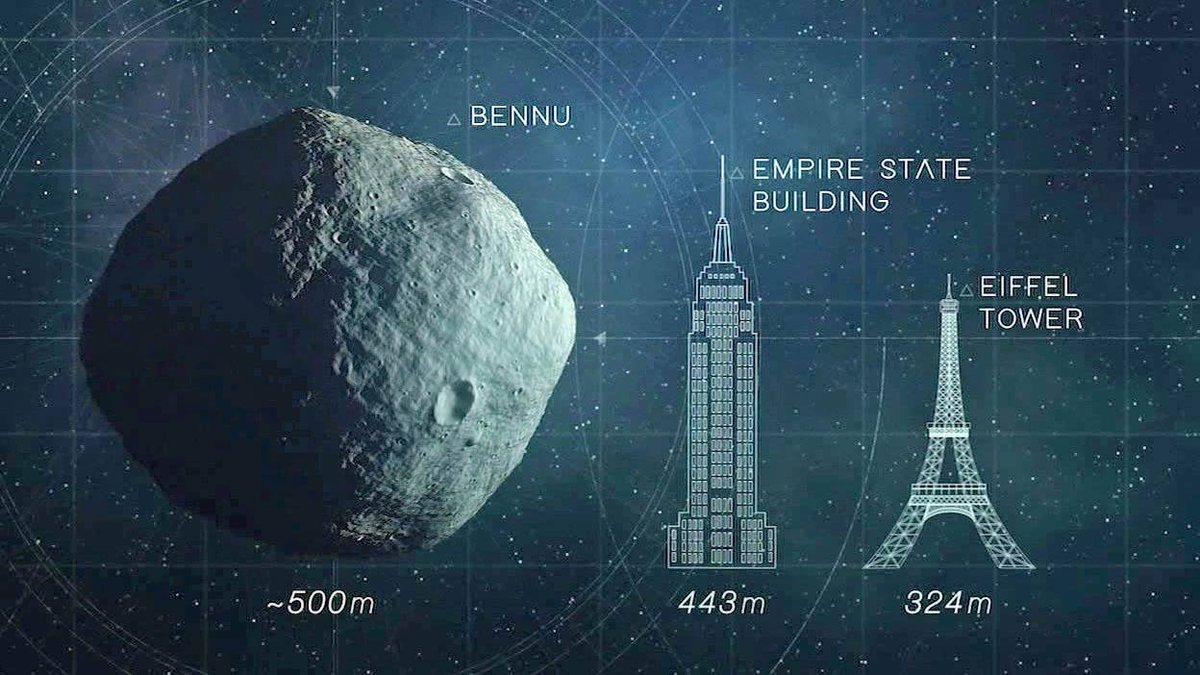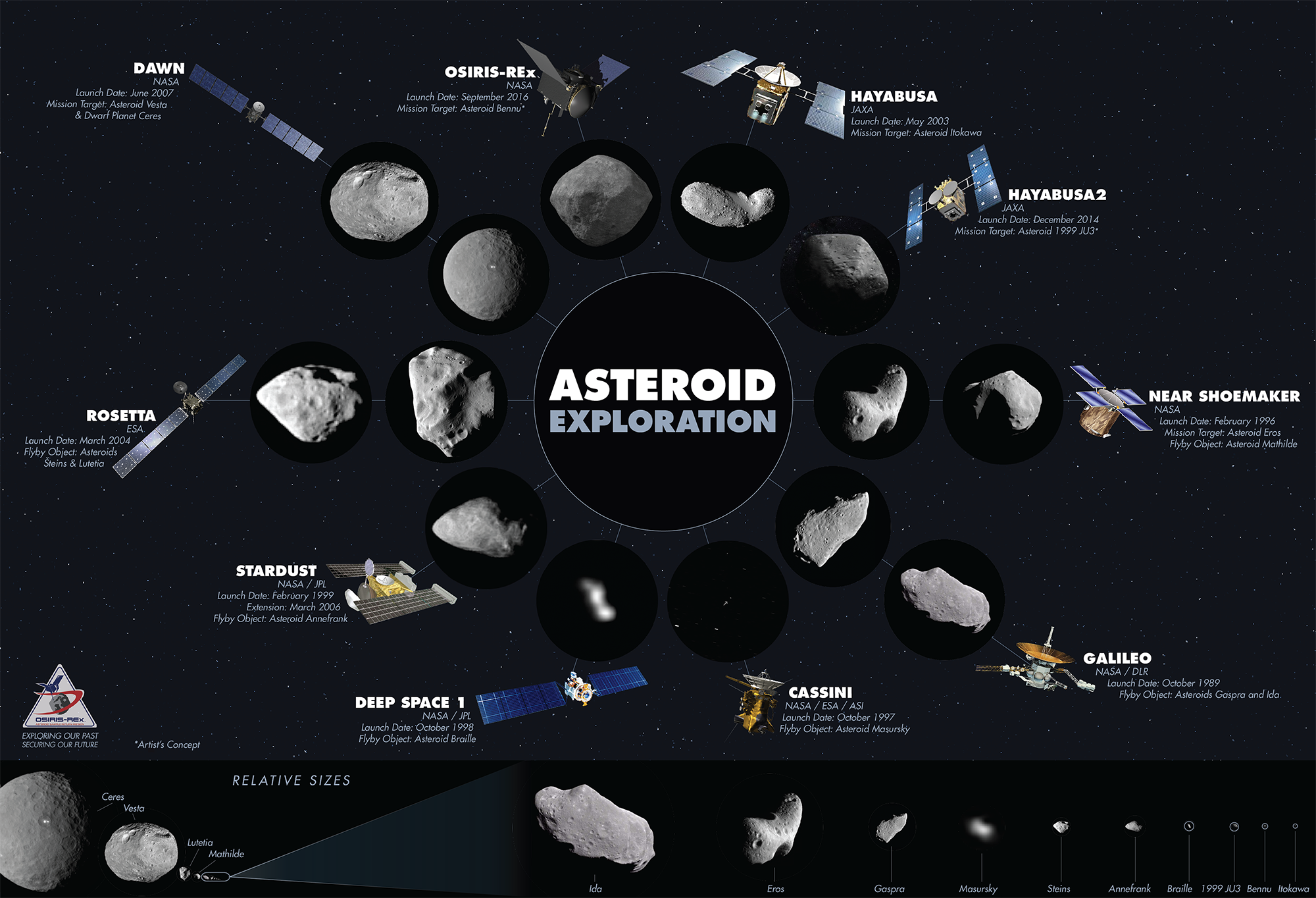Winston
Lorenzo von Matterhorn
- Joined
- Jan 31, 2009
- Messages
- 9,560
- Reaction score
- 1,749
OSIRIS-REx Asteroid Sample Return Mission
https://www.asteroidmission.org/objectives/
After a final correction maneuver scheduled for Nov. 30, the spacecraft will be on track to arrive at a position 12 miles (20 km) from Bennu on Dec. 3.
After arrival, the spacecraft will begin a detailed survey of Bennu. The process will last over a year, and will include identifying and mapping potential sample sites. After the final site is selected, the spacecraft will briefly touch the surface of Bennu to retrieve a sample. The sampling arm will make contact with the surface of Bennu for about five seconds, during which it will release a burst of nitrogen gas. The procedure will cause rocks and surface material to be stirred up and captured in the sampler head. The spacecraft has enough nitrogen to allow three sampling attempts, to collect between 60 and 2000 grams (2–70 ounces).
In March 2021, the window for departure from the asteroid will open, and OSIRIS-REx will begin its return journey to Earth, arriving two and a half years later on Sept. 24, 2023. The sample return capsule will separate from the spacecraft and enter the Earth’s atmosphere. The capsule containing the sample will be collected at the Utah Test and Training Range. For two years after the sample return (from late 2023-2025) the science team will catalog the sample and conduct the analysis needed to meet the mission science goals. NASA will preserve at least 75% of the sample at NASA’s Johnson Space Flight Center in Houston for further research by scientists worldwide, including future generations of scientists.
Ultima in View: NASA’s New Horizons Makes First Detection of Kuiper Belt Flyby Target
https://www.nasa.gov/feature/ultima...s-first-detection-of-kuiper-belt-flyby-target
Mission team members were thrilled – if not a little surprised – that New Horizons’ telescopic Long Range Reconnaissance Imager (LORRI) was able to see the small, dim object while still more than 100 million miles away, and against a dense background of stars. Taken Aug. 16 and transmitted home through NASA’s Deep Space Network over the following days, the set of 48 images marked the team’s first attempt to find Ultima with the spacecraft's own cameras.
"The image field is extremely rich with background stars, which makes it difficult to detect faint objects," said Hal Weaver, New Horizons project scientist and LORRI principal investigator from the Johns Hopkins Applied Physics Laboratory in Laurel, Maryland. “It really is like finding a needle in a haystack. In these first images, Ultima appears only as a bump on the side of a background star that’s roughly 17 times brighter, but Ultima will be getting brighter – and easier to see – as the spacecraft gets closer.”
This first detection is important because the observations New Horizons makes of Ultima over the next four months will help the mission team refine the spacecraft's course toward a closest approach to Ultima, at 12:33 a.m. EST on Jan. 1, 2019. That Ultima was where mission scientists expected it to be – in precisely the spot they predicted, using data gathered by the Hubble Space Telescope – indicates the team already has a good idea of Ultima’s orbit.
The Ultima flyby will be the first-ever close-up exploration of a small Kuiper Belt object and the farthest exploration of any planetary body in history, shattering the record New Horizons itself set at Pluto in July 2015 by about 1 billion miles. These images are also the most distant from the Sun ever taken, breaking the record set by Voyager 1’s “Pale Blue Dot” image of Earth taken in 1990. (New Horizons set the record for the most distant image from Earth in December 2017.)
https://www.asteroidmission.org/objectives/
After a final correction maneuver scheduled for Nov. 30, the spacecraft will be on track to arrive at a position 12 miles (20 km) from Bennu on Dec. 3.
After arrival, the spacecraft will begin a detailed survey of Bennu. The process will last over a year, and will include identifying and mapping potential sample sites. After the final site is selected, the spacecraft will briefly touch the surface of Bennu to retrieve a sample. The sampling arm will make contact with the surface of Bennu for about five seconds, during which it will release a burst of nitrogen gas. The procedure will cause rocks and surface material to be stirred up and captured in the sampler head. The spacecraft has enough nitrogen to allow three sampling attempts, to collect between 60 and 2000 grams (2–70 ounces).
In March 2021, the window for departure from the asteroid will open, and OSIRIS-REx will begin its return journey to Earth, arriving two and a half years later on Sept. 24, 2023. The sample return capsule will separate from the spacecraft and enter the Earth’s atmosphere. The capsule containing the sample will be collected at the Utah Test and Training Range. For two years after the sample return (from late 2023-2025) the science team will catalog the sample and conduct the analysis needed to meet the mission science goals. NASA will preserve at least 75% of the sample at NASA’s Johnson Space Flight Center in Houston for further research by scientists worldwide, including future generations of scientists.
Ultima in View: NASA’s New Horizons Makes First Detection of Kuiper Belt Flyby Target
https://www.nasa.gov/feature/ultima...s-first-detection-of-kuiper-belt-flyby-target
Mission team members were thrilled – if not a little surprised – that New Horizons’ telescopic Long Range Reconnaissance Imager (LORRI) was able to see the small, dim object while still more than 100 million miles away, and against a dense background of stars. Taken Aug. 16 and transmitted home through NASA’s Deep Space Network over the following days, the set of 48 images marked the team’s first attempt to find Ultima with the spacecraft's own cameras.
"The image field is extremely rich with background stars, which makes it difficult to detect faint objects," said Hal Weaver, New Horizons project scientist and LORRI principal investigator from the Johns Hopkins Applied Physics Laboratory in Laurel, Maryland. “It really is like finding a needle in a haystack. In these first images, Ultima appears only as a bump on the side of a background star that’s roughly 17 times brighter, but Ultima will be getting brighter – and easier to see – as the spacecraft gets closer.”
This first detection is important because the observations New Horizons makes of Ultima over the next four months will help the mission team refine the spacecraft's course toward a closest approach to Ultima, at 12:33 a.m. EST on Jan. 1, 2019. That Ultima was where mission scientists expected it to be – in precisely the spot they predicted, using data gathered by the Hubble Space Telescope – indicates the team already has a good idea of Ultima’s orbit.
The Ultima flyby will be the first-ever close-up exploration of a small Kuiper Belt object and the farthest exploration of any planetary body in history, shattering the record New Horizons itself set at Pluto in July 2015 by about 1 billion miles. These images are also the most distant from the Sun ever taken, breaking the record set by Voyager 1’s “Pale Blue Dot” image of Earth taken in 1990. (New Horizons set the record for the most distant image from Earth in December 2017.)







